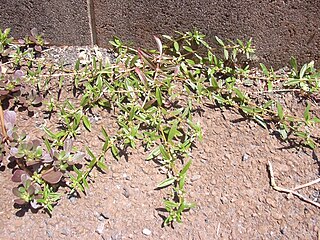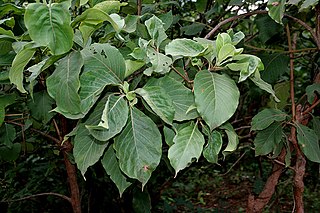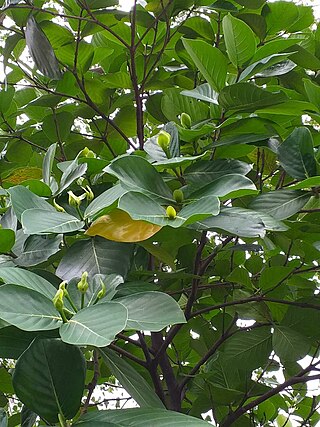
Uncaria is a genus of flowering plants in the family Rubiaceae. It has about 40 species. Their distribution is pantropical, with most species native to tropical Asia, three from Africa and the Mediterranean and two from the neotropics. They are known colloquially as gambier, cat's claw or uña de gato. The latter two names are shared with several other plants. The type species for the genus is Uncaria guianensis.

GastoniaCommerson ex Lamarck is a formerly accepted genus of plants in the ivy and ginseng family, Araliaceae. It had been known as an unnatural group, but was recognized as late as 2010, when its nine species were distributed to four different subgenera of the large genus Polyscias. Because the genus Gastonia is now obsolete, its species are herein referred to by their names in Polyscias.

Meineckia is a genus of flowering plants in the family Phyllanthaceae first described as a genus in 1858.

Vitex is a genus of flowering plants in the sage family Lamiaceae. It has about 250 species. Common names include chaste tree or chastetree, traditionally referring to V. agnus-castus, but often applied to other species, as well.
Arthrophyllum is a defunct genus of plants in the family Araliaceae. It was recognized by most authors until 2010, when all of its 30 species were "sunk" into Polyscias subgenus Arthrophyllum.
Cuphocarpus is an obsolete genus of flowering plants in the family Araliaceae. Mabberley (2008) treated it as a synonym of Polyscias, but other authors still recognized it at that time. In 2010, in a phylogenetic analysis of DNA sequences, it was shown that Cuphocarpus was biphyletic and embedded in the large genus Polyscias. In an accompanying paper, Polyscias was divided into 11 subgenera, with seven species left incertae sedis.

Raukaua is a genus of flowering plants in the family Araliaceae. It has an austral distribution, being indigenous to southern Argentina and Chile, as well as New Zealand and the island of Tasmania.
Reynoldsia is a formerly recognised genus of plants in the ivy family, Araliaceae. In 2003, Kew Gardens published a checklist for Araliaceae, in which eight species were recognized for Reynoldsia: four from Samoa, two from Tahiti, one from the Marquesas, and one from Hawaii. In 2010, a phylogenetic comparison of DNA data showed that Reynoldsia was polyphyletic, consisting of two groups that are not each other's closest relatives. In a companion paper, three of the species were "sunk" into synonymy with others, reducing the number of species to five. All species that were formerly in Reynoldsia are now in Polyscias subgenus Tetraplasandra, a subgenus of 21 species indigenous to Malesia and the Pacific islands.

Oldenlandia is a genus of flowering plants in the family Rubiaceae. It is pantropical in distribution and has about 240 species. The type species for the genus is Oldenlandia corymbosa.

Exostema is a genus of flowering plants in the family Rubiaceae. It consists of trees and shrubs, endemic to the neotropics, with most of the species occurring in the West Indies.

Guettarda is a plant genus in the family Rubiaceae. Most of these plants are known by the common name velvetseed.

Kohautia is a genus of flowering plants in the family Rubiaceae. They are native to tropical areas of Asia, Africa, and Madagascar. Thirty-one species are known. The type species for the genus is Kohautia senegalensis.

Rondeletia is a genus of flowering plants in the family Rubiaceae. It is endemic to the Neotropics. There are around 160 species.

Chiococca is a genus of flowering plants in the family Rubiaceae. It currently holds 23 species that are native to Florida, Texas, Mexico, Central America, much of South America, the West Indies, and the islands of Galápagos and Fernando de Noronha.

Kadua is a genus of flowering plants in the family Rubiaceae. It comprises 29 species, all restricted to Polynesia. Twenty-two of these are endemic to the Hawaiian Islands. Some of the species are common at high elevation. Others are single-island endemics or very rare, and a few are probably extinct. Kadua affinis is widely distributed in Hawaii and is polymorphic. The type species for the genus is Kadua acuminata.
Chione is a monotypic genus of flowering plants in the family Rubiaceae containing the single species Chione venosa. It is native to the neotropics, occurring in most of Mexico, and throughout Central America, the Caribbean, Colombia, Ecuador, and Peru. It is typically a tree growing 10 to 20 meters tall. In harsh habitats, it may be dwarfed and shrubby. It has no known economic use.

Hymenodictyon is a genus of flowering plants in the family Rubiaceae. It has about 30 species. All are native to the Old World. The wood of Hymenodictyon orixense is soft and has limited use, mostly for boxes. The type species for Hymenodictyon is Hymenodictyon orixense.

Adina is a genus of 12 species of flowering plants in the family Rubiaceae. They are shrubs or small trees, native to East Asia and Southeast Asia.

Neonauclea is a genus of flowering plants in the family Rubiaceae. It comprises about 71 species. Neonauclea is a genus of shrubs and trees They are indigenous to China, India, Southeast Asia, Wallacea, New Guinea and Australia.

Hillia is a genus of flowering plants in the family Rubiaceae. It has 24 species, all of which are native to the Neotropics.















